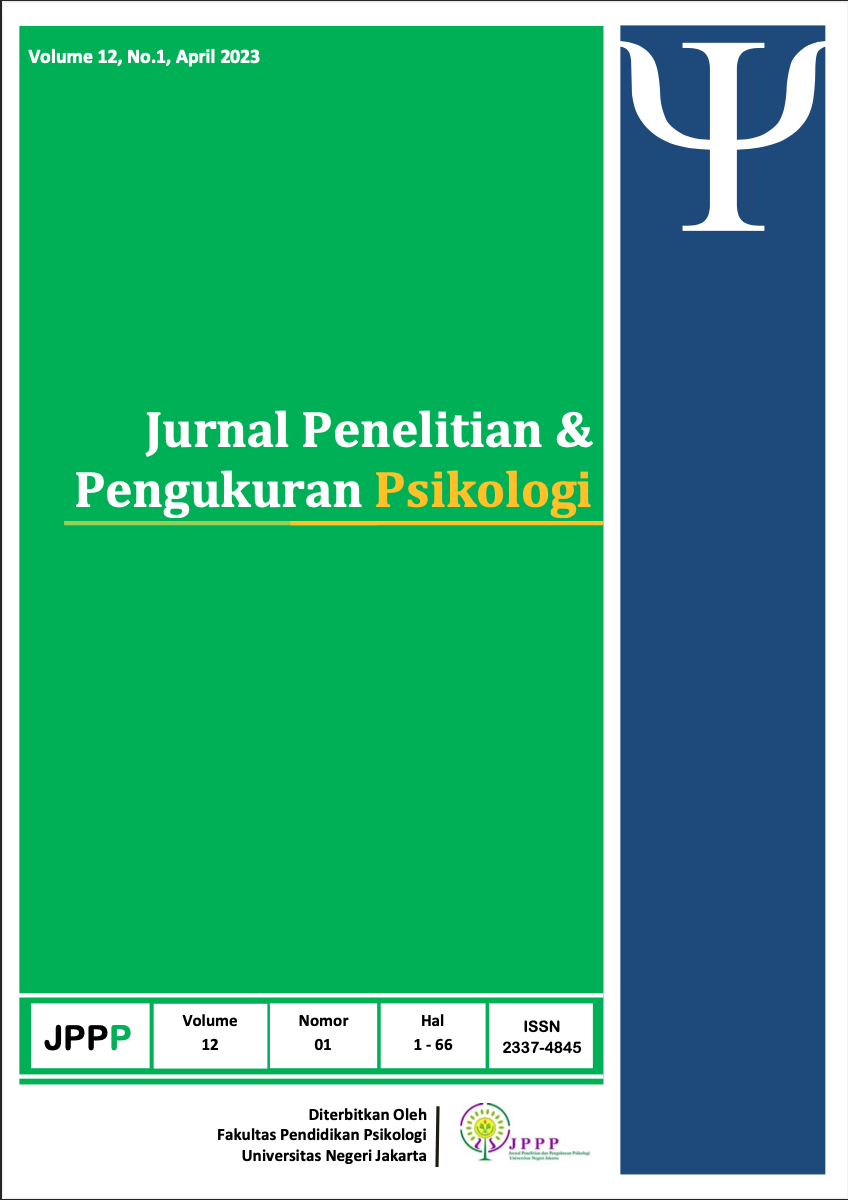Pengembangan dan Pengujian Validitas Skala Perilaku Mengemudi Berbahasa Indonesia
DOI:
https://doi.org/10.21009/JPPP.121.04Keywords:
Driving Behavior Scale, Scale Development, Confirmatory Factor AnalysisAbstract
In 2018, the discourse on creating a psychological test to apply for a driver's license in Indonesia was sounded, but creating the right instrument for a psychological test is not easy. In 2022 scientifically, there is one instrument for the psychological assessment process, but from a psychometric perspective, it still has many weaknesses. Therefore, this research aims to develop a psychological test that meets the elements of good validity and reliability. This study uses the factor analysis method of scale development design. The participants in this study were 323 participants from various cities in Indonesia who voluntarily participated in a series of activities obtained by purposive sampling technique. By testing the content validity with Aiken and construct validity with confirmatory factor analysis, the study found that 24 of the 30 items developed on the Driving Behavior Scale were valid and very reliable. This research implies that the Driving Behavior Scale is suitable as a psychological test for making a driver's license.
References
Asosiasi of Indonesia Automotive Industries. (2020). Hasil sensus BPS: Jumlah kendaraan bermotor di Indonesia tembus 133jt unit. https://www.gaikindo.or.id/data-bps-jumlah-kendaraan-bermotor-di-indonesia-tembus-133-juta-unit/
BPS. (2019). Jumlah kecelakaan, korban mati, luka berat, luka ringan, dan kerugian materi 2017-2019. Badan Pusat Statistik. https://www.bps.go.id/indicator/17/513/1/jumlah-kecelakaan-korban-mati-luka-berat-luka-ringan-dan-kerugian-materi.html
Castillo-Manzano, J. I., & Castro-Nuño, M. (2012). Driving licenses based on points systems: Efficient road safety strategy or latest fashion in global transport policy? A worldwide meta-analysis. Transport Policy, 21, 191–201. https://doi.org/10.1016/j.tranpol.2012.02.003
Chumpawadee, U., Homchampa, P., Thongkrajai, P., Suwanimitr, A., & Chadbunchachai, W. (2015). Factors related to motorcycle accident rist behavior among university students in northeastern Thailand. Southeast Asian J Trop Med Public Health, 46(4), 805–821.
Comrey, A. L. (1988). Factor-analytic methods of scale development in personality and clinical psychology. 56(5), 754–761.
Creswell, J. W., & Creswell, J. D. (2018). Research design: Qualitative, quantitative, and mixed methods approaches (5th ed.). SAGE Publication, Inc.
Fairclough, S. H., Tattersall, A. J., & Houston, K. (2006). Anxiety and performance in the British driving test. Transportation Research Part F: Traffic Psychology and Behaviour, 9(1), 43–52. https://doi.org/10.1016/j.trf.2005.08.004
Henriksson, W., Sundström, A., & Wiberg, M. (2004). The Swedish Driving License Test. Umeå University.
Hjorthol, R. (2016). Decreasing popularity of the car? Changes in driving licence and access to a car among young adults over a 25-year period in Norway. Journal of Transport Geography, 51(February), 140–146. https://doi.org/10.1016/j.jtrangeo.2015.12.006
Huang, C.-C., Wang, Y.-M., Wu, T.-W., & Wang, P.-A. (2013). An empirical analysis of the antecedents and performance consequences of using the moodle platform. International Journal of Information and Education Technology, 3(2), 217–221. https://doi.org/10.7763/IJIET.2013.V3.267
Luo, Y., Turgut, D., & Bölöni, L. (2015). Modeling the strategic behavior of drivers for multi-lane highway driving. Journal of Intelligent Transportation Systems, 19(1), 45–62. https://doi.org/10.1080/15472450.2014.889964
McNeish, D., An, J., & Hancock, G. R. (2018). The thorny relation between measurement quality and fit index cutoffs in latent variable models. Journal of Personality Assessment, 100(1), 43–52. https://doi.org/10.1080/00223891.2017.1281286
Natanael, Y., Salsabilla, R., Aulia, D., Khoirunnisa, D., Munawar, H. N., Hidayat, N. S., & Firdaus, R. F. (2022). Rasch rating scale model: Bias detection and validation Test of Indonesian-Adolescent Life Satisfaction Scale. Psympathic : Jurnal Ilmiah Psikologi, 9(1), 31–44. https://doi.org/10.15575/psy.v9i1.14270
Salsabila, D. F., Rofifah, R., Natanael, Y., & Ramdani, Z. (2019). Uji validitas konstruk Indonesian-Psychological Measurement of Islamic Religiousness (I-PMIR). Jurnal Psikologi Islam dan Budaya, 2(2), 1–10. https://doi.org/10.15575/jpib.v2i2.5494
Septiarly, Y. L., Widarnandana, I. G. D., Ariani, N. W. T., Putra, I. D. G. U., Maharani, K. S., & Putra, I. P. B. O. (2022). Penyusunan tes psikologi form a online untuk surat izin mengemudi (SIM). Jurnal Psikologi Udayana, 9(1), 63. https://doi.org/10.24843/JPU.2022.v09.i01.p07
Siren, A., & Haustein, S. (2015). Driving licences and medical screening in old age: Review of literature and European licensing policies. Journal of Transport & Health, 2(1), 68–78. https://doi.org/10.1016/j.jth.2014.09.003
Tentama, F., & Subardjo. (2018). Pengujian validitas dan reliabilitas konstruk pada organizational citizenship behavior. HUMANITAS, 15(1), 62–71. https://doi.org/10.26555/humanitas.v15i1.5282
Winatro, Y. (2022). Januari-September 2022, korlantas polri catat 94.617 kecelakaan. https://nasional.kontan.co.id/news/januari-september-2022-korlantas-polri-catat-94617-kecelakaan#:~:text=Korps%20Lalu%20Lintas%20(Korlantas)%20Polri,yakni%2070%20ribu%20kasus%20kecelakaan.







